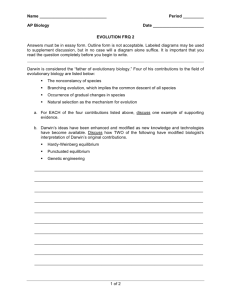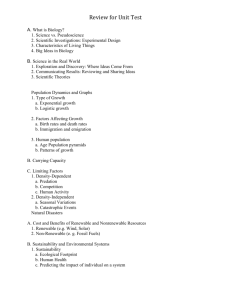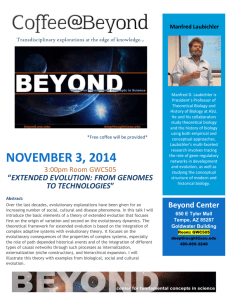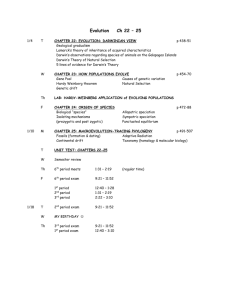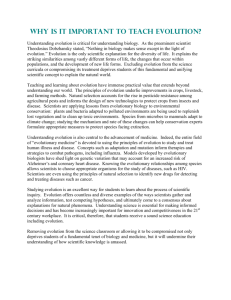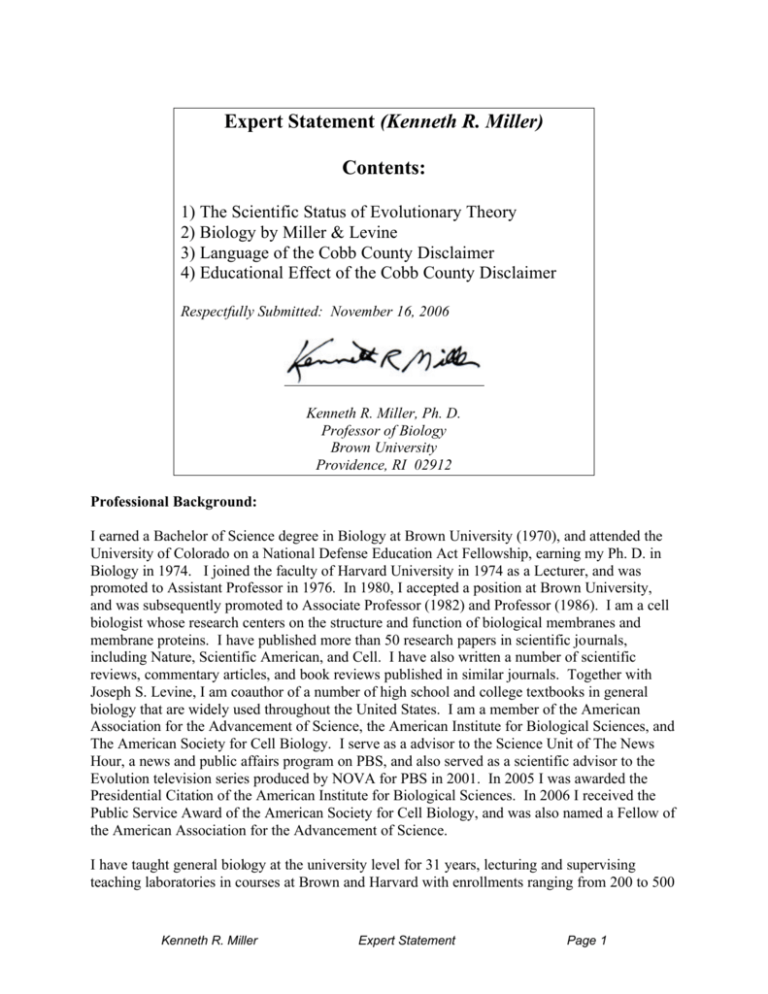
Expert Statement (Kenneth R. Miller)
Contents:
1) The Scientific Status of Evolutionary Theory
2) Biology by Miller & Levine
3) Language of the Cobb County Disclaimer
4) Educational Effect of the Cobb County Disclaimer
Respectfully Submitted: November 16, 2006
Kenneth R. Miller, Ph. D.
Professor of Biology
Brown University
Providence, RI 02912
Professional Background:
I earned a Bachelor of Science degree in Biology at Brown University (1970), and attended the
University of Colorado on a National Defense Education Act Fellowship, earning my Ph. D. in
Biology in 1974. I joined the faculty of Harvard University in 1974 as a Lecturer, and was
promoted to Assistant Professor in 1976. In 1980, I accepted a position at Brown University,
and was subsequently promoted to Associate Professor (1982) and Professor (1986). I am a cell
biologist whose research centers on the structure and function of biological membranes and
membrane proteins. I have published more than 50 research papers in scientific journals,
including Nature, Scientific American, and Cell. I have also written a number of scientific
reviews, commentary articles, and book reviews published in similar journals. Together with
Joseph S. Levine, I am coauthor of a number of high school and college textbooks in general
biology that are widely used throughout the United States. I am a member of the American
Association for the Advancement of Science, the American Institute for Biological Sciences, and
The American Society for Cell Biology. I serve as a advisor to the Science Unit of The News
Hour, a news and public affairs program on PBS, and also served as a scientific advisor to the
Evolution television series produced by NOVA for PBS in 2001. In 2005 I was awarded the
Presidential Citation of the American Institute for Biological Sciences. In 2006 I received the
Public Service Award of the American Society for Cell Biology, and was also named a Fellow of
the American Association for the Advancement of Science.
I have taught general biology at the university level for 31 years, lecturing and supervising
teaching laboratories in courses at Brown and Harvard with enrollments ranging from 200 to 500
Kenneth R. Miller
Expert Statement
Page 1
students. A conservative estimate of student numbers suggests that I have directly taught nearly
10,000 general biology students during that time, and more than 1,000 students in my upperlevel cell biology courses at both schools. When Brown University established a Presidential
award for teaching in the Life Sciences in 1993 (The Leduc Award), I was its first recipient.
Since that time I have received 4 other teaching awards, including Brown University’s Sheridan
Medal for distinguished contributions to teaching and learning. Three decades of teaching
experience have provided me with extensive insights into the ways in which students study and
learn the science of biology, including the science of evolution.
In 1991, Dr. Joseph S. Levine and I authored a general biology textbook (BIOLOGY by Miller &
Levine) published by the Prentice Hall publishing company. The text, which was intended for 9th
and 10th grade biology courses at the high school level, was an immediate success, and has since
that time appeared in 5 different editions, used in every state, including Georgia. In writing this
textbook, I gained an extensive understanding of state curriculum requirements and the ways in
which complex scientific material can be effectively presented to 14 and 15 year old students.
Dr. Levine and I have since written two other textbooks for Prentice Hall, including the so-called
“dragonfly textbook” (also known as BIOLOGY by Miller & Levine), which was selected in 2002
by Cobb County science teachers and the Cobb County Board of education as the best textbook
for their students. Each of these textbooks has been planned and written with careful attention to
scientific accuracy, to student learning patterns and styles, and with the advice of master teachers
and curriculum specialists. Nearly 4 million copies of our textbooks have been produced since
1991, and I would estimate that they have introduced at least 20 million American students to the
wonders of biology. By any standard, this work has provided me with a wealth of experience
into the ways in which science textbooks are understood and received by teachers as well as by
students and their parents.
In 1981 I accepted an invitation to debate the science of evolution with Dr. Henry Morris,
Founder and President of the Institute for Creation Research. Since that first encounter with the
“scientific creationism” movement, I have debated advocated of “creationism” and “intelligent
design” nearly 20 times, and have carefully studied the techniques and tactics of the American
creationist movement. In these debates I have faced the leading advocates of creationism and
intelligent design, including Duane Gish, Michael Behe, Jonathan Wells, William Dembski,
Steven Meyer, Paul Nelson, and Phillip Johnson. I have written several articles dealing with
creationist and “design” challenges to evolution, and served as an expert witness in the Dover
intelligent design trial (Kitzmiller v. Dover) in 2005. In 1999, I wrote Finding Darwin’s God – a
Scientist’s Search for Common Ground, a trade book published by HarperCollins that deals with
both the religious and scientific issues of evolution. This book is now in its 25th printing in
paperback, and is widely used as a text for religion and science courses in colleges and
universities. I have frequently appeared as a spokesman for mainstream science in the mass
media, including commercial and public television and radio, featured in programs such as
NOVA and Science Friday. I am intimately familiar with the tactics employed by the antievolution movement in the United States, and have closely followed their efforts to weaken and
undermine the teaching of evolution throughout the United States.
Kenneth R. Miller
Expert Statement
Page 2
1) The Scientific Status of Evolutionary Theory
Evolution is the process of biological change over time that has characterized life on Earth since
its beginning billions of years ago. An appreciation of the sweeping nature of evolutionary
change developed during the early years of the industrial revolution, when widespread
excavations first began to reveal the Earth’s successive geologic ages. By the end of the 18th
century, pioneering scientists such as Georges Cuvier (1769-1832) had demonstrated that living
things had changed dramatically over time. These discoveries led many naturalists to seek the
forces that might have caused these changes. Best known may be Jean-Baptiste Lamarck (17441829), whose explanations for change focused on the creative power of the environment to shape
the adaptations of organisms over time.
The modern theory of evolution originates in the ideas of Charles Darwin (1809-1882), who
articulated his views in a series of books, the best-known of which is On the Origin of Species
(1859). Darwin’s observations convinced him that forces at work in the world today can account
for the origin of new species, and documented his hypothesis with the results of years of careful
observation and analysis. Darwin’s ideas included a series of testable predictions regarding the
character of the fossil record, the age of the earth, and the nature of inheritance (genetics). In the
years following the first publication of his ideas, each of these predictions was confirmed, and
Darwin’s theory of evolution by natural selection earned general acceptance by the scientific
community. The National Academy of Sciences, the most prestigious scientific body in the
United States, summarized the scientific importance of evolution in this way:
The concept of biological evolution is one of the most important ideas ever
generated by the application of scientific methods to the natural world. The
evolution of all the organisms that live on Earth today from ancestors that
lived in the past is at the core of genetics, biochemistry, neurobiology,
physiology, ecology, and other biological disciplines. It helps to explain the
emergence of new infectious diseases, the development of antibiotic
resistance in bacteria, the agricultural relationships among wild and
domestic plants and animals, the composition of Earth's atmosphere, the
molecular machinery of the cell, the similarities between human beings
and other primates, and countless other features of the biological and
physical world. As the great geneticist and evolutionist Theodosius
Dobzhansky wrote in 1973, "Nothing in biology makes sense except in the
light of evolution." [from Science and Creationism, 1999, preface]
The enduring power of evolution as a scientific idea stems in part from the simplicity of its core
propositions, all of which are strongly supported by accumulating scientific evidence. The first
of these is the observation that life has changed over time. As noted earlier, the historical
realization of the magnitude of such changes was one of the formative elements in Charles
Darwin’s original formulation of evolution. In the 20th century, a dramatic expansion of the
fossil record and its attendant evidence for biological change over time has made the pattern of
biological change abundantly clear.
Kenneth R. Miller
Expert Statement
Page 3
The second core proposition of evolution is that living things share common ancestries. This is a
direct inference drawn from the clear and convincing patterns of change seen in the fossil record.
In cases where fossil records of living organisms are complete enough to trace the pattern of life
over millions of years, the conclusion of common ancestry, also known as descent with
modification, is the only reasonable inference supported by the evidence. One recent example
can be seen in Bruce J. MacFadden’s 2005 review of the fossil record of the horse, which
described the common ancestry shared by this group of organisms as documented in its rich and
detailed fossil history.
Continuing discoveries on several fronts have only served to reinforce this critical element of
evolution. Earlier this year, Daeschler et al (2006) described an extraordinary series of fossil
specimens recovered in the Canadian arctic that serve as unquestioned intermediates between
lobe-finned fish and the first true land vertebrates, or tetrapods. This fossil specimen, given the
scientific name of Tiktaalik roseae, fits neatly into a series of transitional fossils that document
the water-to-land transition that took place in the Devonian period, more than 300 million years
ago. Only a few months later, Long et al (2006) discovered yet another fossil species that fit into
this same transitional series (Gogonasus andrewsae).
These discoveries are not confined to a single portion of the fossil record, nor are they confined
to paleontology. In September of this year a spectacular new juvenile specimen of
Australopithecus afarensis was reported by Alemseged et al (2006). This is the species to which
the famous “lucy” fossil (discovered in 1973 by Donald Johanson and Timothy White) belongs,
and the details of this new specimen have substantially increased our knowledge of this
important period of pre-human evolution. As remarkable as the new fossil discoveries are,
molecular and genetic studies have provided an even more detailed look at the common ancestry
of our own species with our primate relatives. In 2005, a study in the journal Nature (Hillier et
al, 2005) provided unequivocal evidence that human chromosome 2 was produced by a fusion of
two chromosomes from a primate ancestor, and the same journal published the detailed DNA
sequence of the chimpanzee. As the authors of the lead article reporting the chimpanzee genome
noted:
More than a century ago Darwin and Huxley posited that humans share
recent common ancestors with the African great apes. Modern molecular
studies have spectacularly confirmed this prediction and have refined
the relationships, showing that the common chimpanzee (Pan troglodytes)
and bonobo (Pan paniscus) are our closest living evolutionary relatives.
[Mikkelsen et al, 2005]
The third element of the theory of evolution is the proposition that biological change over time is
driven by forces observable in the world today. Darwin noted that living species contain great
reservoirs of diversity, and that additional diversity appears spontaneously (by mechanisms that
include mutation). He argued that the interactions of organisms with their environment selected
for those organisms best-suited to thrive, and that a process known as natural selection resulted.
Natural selection was thought by Darwin to be the primary force driving descent with
modification, or evolution. Evolutionary biologists have confirmed the process of natural
selection through direct observation, but have discovered that other processes also are important
Kenneth R. Miller
Expert Statement
Page 4
in evolutionary change. These include genetic drift, the so-called founder effect, genetic
recombination, transposition, and horizontal gene transfer between species.
In modern science, evolution is far more than the study of events that took place in the past.
Evolution is a hard-working and productive scientific theory put into practice every day by
scientists in a wide variety of fields. Evolutionary theory is used to design new drugs based on
the process of natural selection, to check the spread of insects able to prey upon geneticallymodified plants, and to align and identify genes and DNA sequence data in studies of organismic
genomes. Evolutionary theory provides the basic rationale for the three drug HIV regimen that
has prolonged hundreds of thousands of lives of AIDS patients, and is at the heart of efforts to
control the spread of infectious diseases and microbial drug resistance. This makes evolution a
key weapon in medicine’s battles against infectious killers such as tuberculosis and malaria.
Evolution, like all scientific theories, is necessarily incomplete. Because the evidence of the
Earth’s past is fragmentary, natural history does not document each and every major
evolutionary event in the history of life. Nonetheless, the evidence that we do have abundantly
confirms Darwin’s general ideas regarding evolutionary change, a point also made by the
National Academy in its 1999 report:
So many intermediate forms have been discovered between fish and
amphibians, between amphibians and reptiles, between reptiles and
mammals, and along the primate lines of descent that it often is difficult to
identify categorically when the transition occurs from one to another
particular species. (Science and Creationism, 1999)
All scientific ideas are subject to change, revision, and rejection if they are contradicted by new
evidence, and evolution is not an exception. Nonetheless, in nearly a century and a half of
investigation, not a single piece of scientific evidence has emerged to contradict the idea that a
process of evolutionary change gave rise to the species that exist today. In fact, quite the
opposite is true. Evidence from a wide variety of fields, many not even imagined during the
lifetime of Charles Darwin, has shed light on the mechanism of evolutionary change and further
supported the general outline of his ideas. The concept of evolution, therefore, is not at all
controversial within science, and is generally accepted as the central idea upon which all of
modern biology is based. Underscoring exactly this point, on February 16, 2006, the Directors
of the American Association for the Advancement of Science (AAAS) noted that “Evolution is
one of the most robust and widely accepted principles of modern science. It is the foundation for
research in a wide array of scientific fields and, accordingly, a core element in science
education” (AAAS, 2006).
Evolutionary theory explains the process by which evolutionary change takes place. Darwin’s
general idea of evolutionary change focused on variation within species, acted upon by natural
selection, as the driving force in adaptation and speciation (the formation of new species).
Because his ideas were formed at a time before modern genetics, they did not include the
detailed mechanisms by which variation appears and is acted upon over time. In the early part of
the 20th century, a synthesis of biochemistry, genetics, and evolutionary theory emerged to
produce what became known as neo-Darwinian theory. The neo-Darwinian theory successfully
Kenneth R. Miller
Expert Statement
Page 5
incorporated evolution into the rapidly advancing field of molecular genetics, and enabled
scientists, for the first time, to study and to test evolution at the molecular level.
These advances have led to many refinements of evolutionary theory, and to efforts to
understand and define the relative contributions of scores of processes, including genetic
recombination, transposition, horizontal gene transfer, gene duplication, sexual selection, and
developmental mutations to the process of evolutionary change. There is considerable
discussion and debate within the scientific community as to the relative importance of these and
other mechanisms, and these conflicts continue to motivate vigorous research and investigation.
The emergence of new scientific knowledge ensures that evolutionary theory will remain an
active and productive branch of science for many years to come.
Significantly, none of these debates undermines the scientific standing of evolution itself, despite
the free and open inquiry that characterizes the scientific process. In fact, each of these has
added to our understanding of the ways in which evolution works, and strengthened each of the
core elements of the theory.
2) Biology by Miller and Levine
The coverage of evolution in Biology by Miller and Levine (© 2002) reflects the broad consensus
on evolutionary biology held by the scientific community. To biologists, evolution is the central
organizing idea around which our modern concept of the life sciences is framed. As noted by
the National Academy of Sciences (1998), "The scientific consensus around evolution is
overwhelming. "
Science education standards in Georgia support this view. Georgia Biology Content Standard
SB2 states that “Students will evaluate the role of natural selection in the development of the
theory of evolution,” and the “Evolution of Life” is one of the Georgia Performance Standards
for Biology. The Performance Standard describes a number of key elements that should be part
of the understanding of every student in Georgia as a result of their studies in Biology. These
include:
• The basic idea of biological evolution is that the earth's present-day species
developed from earlier, distinctly different species.
• Molecular evidence substantiates the anatomical evidence for evolution and
provides additional detail about the sequence in which various lines of
descent branched off from one another.
• Natural selection provides the following mechanism for evolution: Some
variation in heritable characteristics exists within every species, some of
these characteristics give individuals an advantage over others in surviving
and reproducing, and the advantaged offspring, in turn, are more likely than
others to survive and reproduce.
• The proportion of individuals that have advantageous characteristics will
increase.
Kenneth R. Miller
Expert Statement
Page 6
Our textbook, Biology, has been written with these requirements very much in mind. Evolution
occupies a prominent position in the textbook, and is explicitly dealt with in Chapters 15-18. In
addition, many other parts of the text, including Chapter 29 ("Comparing Invertebrates") and
Chapter 33 ("Comparing Chordates"), use the notion of common evolutionary ancestry to
explain similarities of structure and function among closely related organisms. This textbook
presents the student with the view of biology shared by the vast majority of working scientists in
the United States and throughout the world. Evolution is presented as an explanation for the
diversity of living organisms and for the rich library of fossil specimens that illustrate the natural
history of life on this planet. Biology therefore meets the requirements of Georgia’s state science
education standards in every respect.
Our approach in Biology has been to emphasize the scientific method and the process of science.
An example of this emphasis can be found in our text:
A useful theory may become the dominant view among the majority
of scientists, but no theory is considered absolute truth. Scientists analyze,
review, and critique the strengths and weaknesses of theories. As new
evidence is uncovered, a theory may be revised or replaced by a more
useful explanation. Sometimes, scientists resist a way of looking at
nature, but over time new evidence determines which ideas survive and
which are replaced. Thus, science is characterized by both continuity and
change. (Miller and Levine, 2002. p. 15)
In line with our emphasis on critical thinking and helping students to understand the history of
science, evolutionary theory is not presented to students as a completed body of work, but rather
as a theoretical solution to the puzzle of life's history and diversity. Section 15-1 of our text
("The Puzzle of Life's Diversity") points out many of the facts and observations that puzzled the
young naturalist Charles Darwin during and after his voyage on H. M. S. Beagle. The attempts
of other naturalists of the 18th and 19th century to deal with these facts are described in section
15-2, including the first comprehensive theory of evolution, developed by Jean-Baptiste
Lamarck.
Lamarck's theory, as described and illustrated on page 376, had many strengths. Among these
was its success in explaining why organisms seem to be so well-adapted to their environments.
Lamarckian theory also helped to explain how organisms had changed over time, as documented
in the fossil record. Despite these strengths, a critical examination of his hypothesis showed
many glaring weaknesses, most notably the lack of any evidence that acquired traits can be
passed on to an organism's offspring. It is against the failure of Lamarck's theory of evolution
that students are first introduced to Darwin's alternative theory.
The elements of Darwin's theory of evolution are laid out on pages 378-382. Once students have
had a chance to see how evolution explains the puzzle of life's diversity, the text then asks
students to examine the evidence in favor of this theory. Very clearly, evolutionary theory has
exceptional strengths, which is why virtually all biologists regard it as the central organizing
principle of the life sciences.
Kenneth R. Miller
Expert Statement
Page 7
The Tentative Nature of Scientific Theory
The need for students to review and critique scientific explanations requires that textbooks
clearly depict the tentative nature of scientific conclusions. We have done this time and time
again, especially in sections of the text that deal with evolution. For example, we describe the
uncertainty inherent in Darwin's explanation of the remarkable diversity of finches on the
Galapagos Islands like this:
Could the island birds have changed over time, as populations in different
places adapted to different local environments? Darwin struggled with this
question for a long time. He finally decided that all these birds could have
descended with modifications from a common mainland ancestor. .
(Miller and Levine, 2002. p. 383)
The tentative nature of Darwin's conclusion, reflected in the language that these birds "could
have descended" from a common ancestor, is reinforced by more detailed discussions of
speciation later in the book (Chapter 16). Although modern evidence from molecular biology
has dramatically reinforced Darwin's conclusions, and even identified the mainland species from
which the island birds arose, we nonetheless describe a "hypothetical scenario" for the evolution
of the Galapagos finches [p. 408], clearly indicating the fact that our reconstruction of these
historical speciation events remains incomplete, as science often is.
The self-correcting nature of science is made clear in our description of vestigial organs (only a
"possibility" for their origin is claimed), and in our discussion of similarities in embryology (the
fraudulent drawings of Ernst Haeckel are pointed out on p. 385), is essential in giving students a
chance to review and critique the scientific adequacy of these explanations.
Scientific theories exist to make sense of the natural world, by tying together the relationships
between myriad facts and observations. In this respect, our prominent mention of continuing
debate on crucial issues such as speciation and the origin of life clearly indicates that
evolutionary theory remains incomplete and unfinished, highlighting some of the uncertainties of
this theory, which exist side-by-side with its remarkable strengths:
A stew of organic molecules is a long way from a living cell, and the leap
from nonlife to life is the greatest gap in scientific theories of Earth’s early
history. …. Another unanswered question in the evolution of cells is the
origin of DNA and RNA. Remember that all cells are controlled by
information stored in DNA, which is transcribed into RNA and then
translated into proteins. How could this complex biochemical machinery
have evolved? Science cannot yet solve this puzzle, although molecular
biologists have made surprising discoveries in this area. (Miller and
Levine, 2002. p. 425)
One of the shortcomings of Darwin's formulation of the theory of evolution was its author's
ignorance of the nature of biological inheritance. Darwin was not alone in this respect, of
course. Like other naturalists working in the middle of the 19th century, his ideas on biological
Kenneth R. Miller
Expert Statement
Page 8
inheritance were highly speculative, and ultimately turned out to be incorrect. In our
introduction to Chapter 16 we point out that:
Without an understanding of heredity, Darwin was unable to explain two
important factors. First, he did not know the source of the variation that
was so central to his theory. Second, he could not explain how inheritable
traits were passed from one generation to the next. (Miller and Levine,
2002. p. 393)
The emergence of modern genetics and molecular biology has helped to fill both of these gaps,
as we explain in Chapter 16. As we note, natural selection can now be studied in more precise
genetic terms, with the result that scientists are now able to model and study the effects of natural
selection on single-gene traits, on polygenic traits, and on entire populations. The results of such
studies, significantly, have not been to weaken the theory of evolution. Quite the contrary — the
application of genetic and molecular techniques to the study of evolution has enhanced our
appreciation of the nature of evolutionary change and strengthened the status of evolution as the
central organizing principle of the science of biology.
3) Language of the Cobb County Disclaimer
It is my understanding that in 2002 the Cobb County Board of Education decided to affix a
sticker to student editions of several science textbooks with this wording:
This textbook contains material on evolution. Evolution is a theory, not a
fact, regarding the origin of living things. This material should be
approached with an open mind, studied carefully, and critically considered.
This statement singles out evolution in a way that misrepresents its scientific standing, misleads
students as to the nature of science theories, conveys a false sense of certainty with regard to
other scientific theories, and serves, as far as I am able to tell, no scientific or educational
purpose.
Calling Special Attention to Evolution
While the first sentence of the statement is obviously true, since each of the textbooks to which it
was affixed did indeed contain material on evolution, students reading it will immediately
wonder why it is necessary to point this out. Most of the textbooks to which it was affixed
clearly list evolution in their tables of content, and a few present it even more prominently. For
example, BIOLOGY by Miller & Levine, the text of which I am coauthor, lists evolution as a
major topic on its back cover. The presence of evolution in these biology textbooks would
therefore come as no surprise to their student readers. Those readers will, however, immediately
wonder why the Board felt the need to point out this particular element of textbook content in
such a direct way. Clearly, in the opinion of the Cobb Board, there is something genuinely
special about evolution that needs to be drawn to the students’ attention.
Kenneth R. Miller
Expert Statement
Page 9
The effect of citing evolution, and only evolution, in this way has the obvious effect of
suggesting to students that the scientific support for evolution is weak, and that students should
hold this particular theory up for special scrutiny. In reality, evolutionary theory enjoys the same
status as other well-tested explanations in science, and there is no rational basis for suggesting
that it, and it alone, should be mentioned in the context of doubt and skepticism that pervades
this statement from the Cobb County Board of Education.
Misrepresenting the Meaning of a Theory
The Board statement tells students that “Evolution is a theory, not a fact,” regarding the origin of
living things. This statement is clearly designed to mislead students about the nature of scientific
theories in general and evolution in particular.
The Board’s emphasis that the theory of evolution is “not a fact” might be appropriate if they had
pointed out instead that no scientific theory is a fact, and that all scientific theories continue to be
tested in light of new scientific discoveries. Instead, their claim that evolution is “not a fact” is
clearly designed to undermine the scientific standing of evolution. The statement clearly implies
that if science were certain of the validity of evolutionary theory, it might some day be regarded
as a fact. The important point to be made is that scientific theories don’t ever become facts;
rather, scientific theories explain facts. We do not expect, by reason of analogy, that atomic
theory will ever become known as “atomic fact,” regardless of the weight of evidence supporting
it. The Board’s language clearly has the effect of promoting student misunderstanding as to the
nature and validity of scientific theories.
Three decades of teaching have taught me that the scientific meaning of “theory” is easily
misunderstood by students. This is a problem with the university students in my classes, and it is
certainly a difficulty for the high school students for whom my textbook is written. A majority
of students, in my experience, regard a “theory” as a hunch or casual guess. My professional
judgment as an educator is that the language of the Cobb County disclaimer plays directly to this
misunderstanding. Rather than clarifying the true meaning of a scientific theory, it amplifies and
validates a common student misunderstanding. As such, it is counter-productive to good science
education.
Directly stated, my objection to this sentence is not that it describes evolution as a “theory.”
Indeed, Chapter 15 of my own textbook is entitled “Darwin’s Theory of Evolution.” Rather, the
difficulty arises from the sticker’s assertion that evolution is a “theory, not a fact,” implying that
facts represent a higher level of understanding than theories. Since theories persist in science
only when they are broadly supported by factual evidence, they actually represent a higher level
of understanding than facts. The language of the Cobb County disclaimer, in other words, gets it
exactly backwards. One is left to wonder why this is so.
Conveying a False Sense of Scientific Certainty
In its eagerness to undermine student confidence in the descriptions of evolutionary biology
presented in their textbooks, the disclaimer’s concluding sentence warns that “This material
Kenneth R. Miller
Expert Statement
Page 10
should be approached with an open mind, studied carefully, and critically considered.” At first
glance this would seem to be a straightforward admonition that students should apply critical
thinking skills to their life science studies. If this were the case, however, the sentence might
have suggested that such skills should be applied to all topics within the textbook. Instead, the
wording carefully tells students that open mindedness and critical thinking should be applied to
only “this material,” which is, of course, evolution. The student is left to wonder why one does
not need an open mind to study cell biology or why the germ theory of disease should not be
subjected to critical consideration. The obvious implication is that the other topics in the
textbook rise to a level of certainty that makes such careful analysis unnecessary. That is not the
case, according to the Cobb County Board of Education, for evolution.
I object to this final sentence not as an evolutionist — but as an experimental cell biologist. By
implication, the Board’s wording tells students that they can be certain of the validity of every
subject presented in their textbooks — except for evolution. What this means, of course, is that
the fundamental questions in every field of biology, except for evolution, have been definitively
answered. Were students to take this language to heart, they would see no reason to pursue
careers in research, since, according to the Cobb County Board of Education, there is little left to
discover. How can there be, when students are told that careful study, open-mindedness, and
critical consideration are not necessary for any field of study other than evolution?
Here again, the language of the disclaimer sets evolution apart from the rest of the biological
sciences, doing serious damage to student understanding. By attempting to establish evolution’s
uncertain status as worthy of careful, critical analysis, they foolishly present the rest of biology
as so firmly established that it is beyond such treatment. The false sense of certainty about the
rest of biology conveyed by this wording does further damage to student understanding.
A Revised Disclaimer
If the goal of the Cobb County Board of Education was to promote critical thinking in biology
classes, there are many ways in which this might have been accomplished. They could have
requested that their curricular staff organize workshops in critical thinking for their teachers, they
might have prepared lesson plans that emphasize the critical thinking exercises already present in
textbooks and other materials, or they might have composed a quite different disclaimer to be
inserted in their textbooks. The wording of such an alternate disclaimer, following the threesentence format of the Board’s 2002 resolution, might read like this:
This textbook contains material on science. Science is built around
theories, which are strongly supported by factual evidence. Everything in
science should be approached with an open mind, studied carefully, and
critically considered.
Clearly, evolution, as one of many subtopics in biology, would be included in a call for critical
consideration by the wording of such a disclaimer. It would not, however, be singled out for
special treatment. Nor would students be confused by an incorrect distinction between “facts”
and “theories,” or by an incorrect implication of certainty in other fields of biology.
Kenneth R. Miller
Expert Statement
Page 11
Despite the ease with which such a disclaimer might have been composed, the Board obviously
chose different wording, leading to the current case.
The Creationist Movement and its use of the term “Theory”
While one cannot know the thoughts of individual Board members who approved the
disclaimer’s wording, the context in which this disclaimer appeared leaves no doubt as to its
intent and ultimate effect. In the Spring of 1981, during my first full year of teaching at my
current institution, I was approached by a group of undergraduate students and asked to debate
Dr. Henry Morris, a self-described “scientific creationist.” Dr. Morris was, in fact, the Founder
and President of the Institute for Creation Research, and was the acknowledged leader of the
“scientific creationism” movement in the United States. Although I was unfamiliar with
scientific creationism as I prepared for our debate, I quickly became aware of the strategies and
tactics employed against the teaching of evolution by this movement.
One of these strategies was a deliberate attempt to mislead the public as to the nature of a
scientific theory. Knowing that biologists routinely make reference to the “theory of evolution,”
Dr. Morris and other creationists routinely emphasized that evolution was just a theory and had
not been proved, implying that it should be greeted with a greater degree of skepticism than other
scientific ideas.
The late Stephen Jay Gould described this portion of the creationist strategy this way:
In the American vernacular, "theory" often means "imperfect fact"--part of
a hierarchy of confidence running downhill from fact to theory to
hypothesis to guess. Thus the power of the creationist argument: evolution
is "only" a theory and intense debate now rages about many aspects of
the theory. If evolution is worse than a fact, and scientists can't even make
up their minds about the theory, then what confidence can we have in it?
[Gould, 1994]
Since my 1981 debate with Morris, I have accumulated 25 years’ of experience in dealing with
the arguments, strategies, and tactics of the creationist movement. Every manifestation of the
movement has employed the “theory not fact” tactic, including the more recent groups
advocating the variety of creationism known as “intelligent design.” Indeed, the intelligent
design initiative begun by the Dover, PA, Board of Education in 2004 employed “theory not
fact” language nearly identical to that found in the Cobb County Disclaimer:
Because Darwin’s Theory is a theory, it continues to be tested as new
evidence is discovered. The Theory is not a fact. [Dover Board of
Education Statement on Evolution and Intelligent Design, cited in
Kitzmiller v. Dover, 2005]
Common to both statements is a false dichotomy between theory and fact that is clearly designed
to mislead students as to the scientific standing of evolution, and to promote alternate ideas such
as creationism and intelligent design.
Kenneth R. Miller
Expert Statement
Page 12
4) Educational Impact of the Cobb County Disclaimer
As stated earlier, I am coauthor, with Joseph S. Levine, of a series of high school general biology
textbooks published by the Prentice Hall Company. I travel regularly on behalf of my publisher,
meeting with teachers, parents, and students throughout the United States, and presenting
workshop on biology education. In an average year, I spend roughly 30 days involved in such
activities, speaking to an average of 50 educators in the course of each presentation. This means
that in a typical year I meet more than 1,000 educators, engaging in detailed discussions with
many of them on issues of science education. Considering the fact that our first textbook
appeared in 1991, it is fair to say that over the 15 years that have followed I have gathered a
great deal of professional information on biology education in American schools.
In meeting with teachers, I have often discussed the issue of special disclaimers or “stickers” of
the sort applied by Cobb County to its textbooks. Their responses overwhelmingly indicate that
they do not regard such special statements as conducive to good educational practices. A
warning label that singles out a single scientific theory for special scrutiny sends an unsubtle
message to students that something is seriously wrong with that theory. This, as teachers
recognize, is exactly what the Cobb County wording was designed to do, and it will clearly have
that effect in any classroom where it is present.
One might argue, of course, that the sticker is required to counteract the dogmatic and inflexible
way that evolution is presented in a textbook, but this argument could be made only by
deliberately overlooking the way in which our text (Biology by Miller & Levine) covers the
subject. As noted earlier in this statement, we are careful to point out the tentative nature of
scientific theories to students, and do indeed present evolution as such a theory. However, by
stating that “evolution is a theory, not a fact,” the Cobb County statement turns the relative
meanings of “theory” and “fact” on their heads. Evolutionary theory is broadly supported by
scientific fact, and to say that it is “not a fact” is to deliberately imply otherwise. This is directly
at variance with the mainstream view of evolutionary biology that is found in our text, required
by the Georgia science standards, and supported by the American scientific community.
Specifically, the “not a fact” wording of the Cobb statement directly contradicts the explanation
of scientific “theory” in the opening pages of our textbook:
You may have heard the word theory used in everyday conversations as
people discuss ideas. Someone might say, “Oh, that’s just a theory,” to
criticize an idea that is not supported by the evidence. In science, the
word theory applies to a well-tested explanation that unifies a broad
range of observations. A theory enables scientists to make accurate
predictions about new situations. (Biology by Miller & Levine, 2002. P. 14)
Ironically, the usage of “theory not a fact” language by the Cobb Board of Education employs
exactly the meaning of “theory” that our textbook warns against in its very first chapter.
Therefore, in its efforts to undermine the theory of evolution, the Cobb sticker contradicts our
Kenneth R. Miller
Expert Statement
Page 13
very best efforts, and those of the educators of Cobb County, to educate the students of Cobb
County as to the meaning of this important scientific term.
Kenneth R. Miller
Expert Statement
Page 14
References
AAAS (2006) Statement on the Teaching of Evolution. Published by the American Association
for the Advancement of Science Board of Directors, February 16, 2006.
Alemseged, Z. et al (2006) A juvenile early hominin skeleton from Dikika, Ethiopia. Nature
443: 296–330
Daeschler, E. B., Shubin, N. H., and Jenkins, F. A. (2006) A Devonian tetrapod-like fish and
the evolution of the tetrapod body plan. Nature 440: 757-763.
Gould, S. J. (1994) “Evolution as Fact and Theory;” from Hen's Teeth and Horse's Toes,
New York: W. W. Norton & Company, pp. 253-262.
Hillier et al (2005) “Generation and Annotation of the DNA sequences of human
chromosomes 2 and 4,” Nature 434: 724-731.
Kitzmiller et al v. Dover (2005) Memorandum Opinion, case Case No. 04cv2688.
Long, J. A., Younng, G. C., Holland, T., Sender, T. J., and Fitzgerald, E. M. G. (2006)
An exceptional Devonian fish from Australia sheds light on tetrapod origins.
Nature 444: 199 - 202.
MacFadden, B. J. (2005) Fossil Horses — Evidence for Evolution. Science 307: 17281730.
Mikkelsen et al (2005) Initial sequence of the chimpanzee genome and comparison
with the human genome. Nature 437: 69-87.
Miller, K. R., and Levine, J. S. (2002) Biology (a high school textbook) Pearson –
Prentice Hall, New York, NY.
National Academy of Sciences of the United States (1998) Teaching about Evolution
and the Nature of Science. National Academy Press, Washington, DC.
National Academy of Sciences of the United States (1999) Science and Creationism.
National Academy Press, Washington, DC.
Kenneth R. Miller
Expert Statement
Page 15



